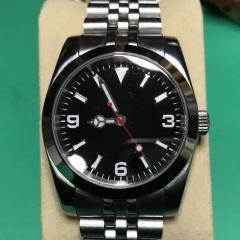Waltham 155 Movement From 1900 - Advice Please
-
Recently Browsing
- No registered users viewing this page.
-
Topics
-
Posts
-
You're 100 % correct! I'm only interested in dissecting a counterfeit movement, and after that, destroying it. As a general rule, I would never buy, wear, or sell a counterfeit watch or movement. In this case, I'm willing to make an exception, as I want to get a feel for what a really good counterfeit feels like so I can better identify counterfeits. Thanks, that will be helpful! I absolutely see where you're coming from, and I'm basically in the same camp. However, I'm willing to make an exception if the purpose is to gain knowledge which will help to better combat counterfeits, and the movement isn't used for any other purpose than dissecting it and finally destroying it. Looking at the link provided by @GuyMontag most of the time we won't have any problem identifying a counterfeit. As experienced repairers of genuine Rolex movements, I would guess we would be able to identify a counterfeit in seconds. However, a well-made super clone of the movement might be harder to detect, and that's why I'm investigating the possibility of getting one. Thank you for your input and for helping clarify the situation — much appreciated. We’re right on topic. I’m currently servicing my second Rolex 3135 movement for a client, and I started this thread to document and discuss any issues or anomalies that may arise during the work. During disassembly, I encountered a few screws that, to me, appeared inconsistent with what I would think are typical Rolex finishing standards. This initially raised concerns that I might be dealing with a high-grade counterfeit or "super clone." Fortunately, those concerns were laid to rest, but the experience highlighted the importance of being able to reliably identify counterfeit components.
-
By LittleWatchShop · Posted
I suggest FreeCAD as the tool to use for 3D design. It is free open source. For Android phones, I use "Watch Accuracy Timer" For cleaning, just get a class dish and soak the movement parts in fluid. Dry on lint free paper under an incandescent lamp. Once you decide to invest in the hobby, there are many ideas for DIY cleaning machines and chemicals. I use traditional spin machines and the expensive L&R fluids. I have invested $$$$$$ into this "hobby" but I have the means to do crazy stuff. I do exactly what he does for rinse. I use the L&R Master designed for two rinse jars PLUS an extra rinse jar. Great video -
Have a look here, quite a good video about cleaning without a machine Tom
-
Thank you very much for being extremely helpful and patient. I know a guy who can 3dprint, I can design a spacer I guess. For cleaning with the lighter fluid, is it entirely done by hand, or do I need a jig (spinner?). Any informative links appreciated! Would you have any suggestions for the app? I'll test it on my Slava.
-
I did wonder about the feasibility of mixing two oils. I am guessing that 9010 / 9020 or HP500 / HP1300 would be a better mix than 9010 / HPxx. Some people might think that was heresy but I guess the only consequence is that you might have to service the movement again if you got a poor result.
-






Recommended Posts